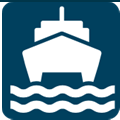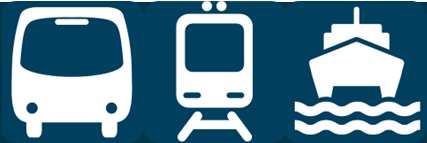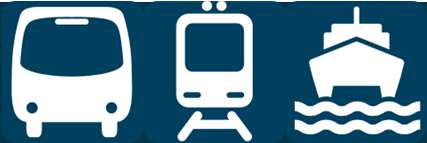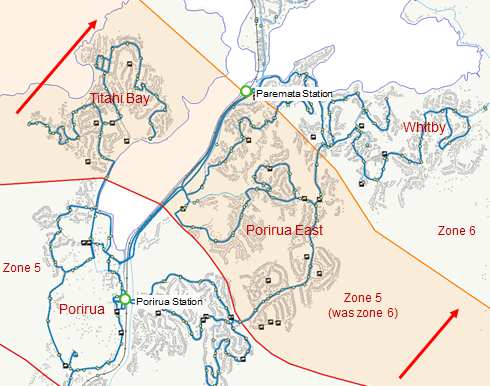Greater Wellington Regional Council
Proposed variation to fare policies in the Regional Public
Transport Plan 2014 (variation 3)
Supporting documentation and statement of proposal
August 2017
IFT-10-200
Better Metlink fares proposed variation – August 2017
Contents
1.
Introduction ............................................................................................................................... 3
2.
Current policies in the PT Plan ................................................................................................... 3
3.
Review of the current fare policies in PT Plan ............................................................................ 4
3.1.
Fare review process .......................................................................................................................... 4
3.2.
Fare policy outcome ......................................................................................................................... 5
4.
PT Plan variation ........................................................................................................................ 5
4.1.
New concession fares policy ............................................................................................................. 6
4.2.
New policy to reward target behaviours .......................................................................................... 7
4.3.
Changes to major initiatives ............................................................................................................. 8
5.
Proposed fare changes .............................................................................................................. 8
6.
Funding implications................................................................................................................ 11
7.
Timing ...................................................................................................................................... 11
Appendices ..................................................................................................................................... 12
Appendix
A Regional Public Transport Plan 2014: Variation to fare policies (Variation 3) .............. 12
Appendix B Policy options considered for off-peak fares and targeted concessions ....................... 16
Appendix C Proposed fare schedule ................................................................................................ 21
Appendix
D Proposed fare changes ................................................................................................. 23
Better Metlink fares proposed variation – August 2017
Page 2 of 31
1. Introduction
Greater Wellington Regional Council is proposing to change fare policies in Wellington’s Regional Public
Transport Plan 2014 (PT Plan) and implement a package of fare initiatives.
The changes we are proposing have come about following a comprehensive review of the fares and
ticketing components of the PT Plan over the last year. The review included examination of fare structure,
fare pricing, options for transition of fares and fare products and policies on concessions and discounts,
including consideration of new initiatives such as a tertiary student concession.
The review concluded that majority of fare initiatives we are proposing in this document (and that are
summarised in the
Better Metlink Fares document) to be consistent with the existing policies and actions in
the PT Plan.
The proposal to introduce a targeted concession for tertiary students and blind and disabled passengers is
the only area that is inconsistent with the existing PT Plan policy. A variation is required to facilitate these
concessions. To do so requires two new policy settings:
• New concession fares policy
• New policy to encourage more frequent use of public transport, more off-peak travel and
greater use of electronic ticketing.
While only minor policy changes, the changes trigger the PT Plan significance policy due to the
changes
having a moderate impact on a large number of residents1. The approach to vary the PT Plan therefore
triggers the need to follow Council’s Special Consultative Procedure and as part of this, prepare a
Statement of Proposal as the basis for consultation.
The purpose of this document is to firstly: set out the nature of changes we are looking to make to the PT
Plan; and secondly, describe the fare initiatives that we propose to bring from July 2018. In accordance
with requirements for the Special Consultative Procedure, this document also provides options and analysis
for proposing the ‘significant’ variation the PT Plan.
The summary consultation document
Better Metlink Fares has been prepared for public feedback on the
changes. A copy of
Better Metlink Fares and further information on the fares changes is available on our
website at www.gw.govt.nz/have-your-say.
2. Current policies in the PT Plan
The fares and ticketing policies and actions for the region are set out in the PT Plan. The PT Plan includes
the following objectives and policies, which, along with supporting actions, are described in sections 5.3
and 5.8 of the PT Plan:
•
Objective 3: A fares and ticketing system that attracts and retains customers
o Policy 3(a): Implement a fares and ticketing system that supports the integration of the
public transport network
o Policy 3(b): Simplify the existing fare structure
o Policy 3(c): Provide concession fares for targeted groups
o Policy 3(d): Review fare levels annually to achieve farebox recovery targets with a
preference for small, regular adjustments rather than large, infrequent one
o Policy 3(e): Ensure that all users pay the correct fares
1 Excerpt from PT Plan significance policy in section 6.1 of the PT Plan
Better Metlink fares proposed variation – August 2017
Page 3 of 31
•
Objective 8: Sustainable funding arrangements that balance user contributions (fares) with public
funding
o Policy 8(b): Achieve farebox recovery targets
o Policy 8(c): Advocate for sustainable funding for the Wellington public transport network
The PT Plan also includes a major new improvement initiative to implement the findings of the 2013 fare
structure review and introduce integrated fares and ticketing across the Metlink network (refer section 4.5
of the PT Plan).
The following changes
are proposed in the current PT Plan:
• Within three years:
o Free travel for children under five years old
o 50% discount for children and young adults aged from five to 18
o 25% off-peak discount to replace other concession fare discounts
o Free off-peak travel for Supergold card holders
o Weekend family pass
• Longer term:
o Free transfers
o Capping fares, where the total fare paid for a specified period is capped
o Bulk purchase scheme, enabling group purchases at a discounted rate
The following changes were considered but are
not proposed in the current PT Plan:
• 25% concession fare for tertiary students
• 50% concession fare for tertiary students
• 50% off-peak discount
• 50% concession for adults with disabilities receiving Supported Living Payment
The 10 Year Plan adopted in 2015 provided funding for the proposed changes identified above. Since then,
the environment has changed, which has required us to respond with modifications to our funding
programmes. In our Annual Plan 2016/17, and through the consultation process, we advised you of some of
the adjustments we needed to make for that year and these have a flow-on effect for the 2017/18.
3. Review of the current fare policies in PT Plan
3.1. Fare review process
The Council decided in June 2016 to review the fare policies in the Wellington Regional Public Plan 2014.
The review was undertaken to re-examine the high-level policy for fares set out in the PT Plan, including
fare structure, fare pricing, transfers between vehicles, operators and modes, and policies on concessions,
including new initiatives such as a tertiary student concession. It also considered options for rationalising
fares in preparation for new ticketing systems and options (including fare or rate increases) to fund specific
fare initiatives.
Key stakeholders were consulted and a reference group was established in the early stages of the review to
test ideas and guide the process. The process involved a detailed long list and short list evaluation against
the following review objectives:
1. To provide a simple and easy to understand fares regime for customers
2. To promote fairness and affordability for customers and funding partners
3. To implement a fares and ticketing system that attracts and retains customers
4. To support integration of the public transport network and the transition to Integrated Fares and
Ticketing.
Better Metlink fares proposed variation – August 2017
Page 4 of 31
A series of workshops were held with councillors over the New Year to present findings of the review and
to seek direction on what (if any) fare initiatives or fare increases should be included in the 2017/18 draft
Annual Plan consultation document. As a result, the draft Annual Plan consultation document did not
propose changes to fares over the 2017/18 year, but signalled an intention to bring in a package of fare
initiatives in mid-2018 to align with the new bus contracts and the extension of Snapper as an interim bus
ticketing system.
The following proposal was included in the 2017/18 Annual Plan consultation brochure:
“In 2017/18 we are not intending to make any changes to fares. This includes no increase to public
transport fares, which would have been held for four successive years.
Our 10 Year Plan provided an allowance for free transfers and off peak discounts, and fare structure
review initiatives from 2017/18. We are now signalling our intention to bring in the package of fare
initiatives in 2018/19 to align with the new bus contracts and the extension of Snapper as an
interim bus ticketing system. The fare initiatives will be based on a review of the fare policies
outlined in the Regional Public Transport Plan, and include off-peak discounts, transfer discounts,
changes to one fare boundary and standardisation of fare rules. We also intend to consider a fare
discount for tertiary students. Fare changes will form part of a comprehensive package of
improvements to how public transport is delivered to our customers, including new bus networks,
new bus operating contracts, new bus vehicles and new ticketing systems. We will have to also
consider how the package of fare changes is funded and any fare increases that will be required at
that time.”
At its meeting of 9 May 2017 (Report 17.123), the Committee agreed to finalise the package of initiatives
and for public consultation during August/September 2017. This report sets out that proposed package of
initiatives and proposed variation to the Wellington Regional Public Transport Plan 2014 that is required for
some of these changes.
3.2. Fare policy outcome
Assessment of the policies and actions in the PT Plan through the review, found that while the policies
remain relevant, a variation to the PT Plan is required to amend the policies around off-peak fares and
targeted concessions. The PT Plan variations looks to retain a policy for off-peak fares – but also to provide
a concession fare to improve access to affordable public transport for those most dependent on public
transport.
4. PT Plan variation
The PT Plan variation looks to retain a policy for off-peak fares – but also to provide a concession fare to
improve access to affordable public transport for those most in need and dependent on public transport.
The new concession fare is proposed for full-time tertiary students and customers with special accessibility
needs (blind and disabled). In coming to this conclusion, the policy options below were considered, with
option C the preferred option. The two major policy changes are further discussed under sections below.
Option
Policy justification
A. Off-peak fares with child
• Better use of spare capacity
concession (existing policy)
• Improve off-peak affordability for everyone
• No need to pick winners and losers
•
Conclusion: Possible option
B. Targeted concessions
• Improve affordability for groups most in need
no off-peak
• Doesn’t address peak capacity
Better Metlink fares proposed variation – August 2017
Page 5 of 31
•
Conclusion: Not recommended
C. Targeted concessions with off-
• Separate policies reflect different drivers.
peak
• Concessions improve affordability for some
• Off-peak spreads peak demand
•
Conclusion: Preferred option
D. No targeted concessions and no
• Improves affordability for everyone both peak and off-peak
off-peak
• Doesn’t address peak capacity
•
Conclusion: Not recommended
4.1. New concession fares policy
The most fundamental change we are proposing relates to the PT Plan policy on targeted concessions for
specific groups. The concession fare is proposed for full-time tertiary students and customers with special
accessibility needs (blind and disabled).
The current approach in the PT Plan is to replace all targeted concessions (other than child) with an off-
peak discount. This approach was put forward to encourage people who do not have to travel at the
busiest times to schedule their trips when there is spare capacity on the network. It also provides a more
affordable option for customers. The ‘off-peak only’ approach avoids having to choose winners and losers
when making decisions about which groups of customers should receive fare concessions.
4.1.1. Why a concession for full-time tertiary students
The proposal for a concession fare for full-time tertiary students followed analysis of the options and
engagement with the public on the 2017/18 Annual Plan (recently adopted). Significant feedback was
provided through submissions and at the hearing in support of a tertiary concession. Support for a tertiary
concession was based on:
• Requests for parity of approach with other regions with student populations (Wellington being the
only region not offering a region-wide tertiary discount)
• Commentary that students would not gain much benefit from off-peak fares as they have no
control over lecture times which often required peak travel
• Changing patterns of travel and growing affordability issues (particularly with increasing housing
costs in Wellington City) resulting in more students living at home and in locations far from the
place of study
• Indication from the tertiary education sector and other regional partners (including Wellington City
Council) of their willingness to work with Greater Wellington Regional Council to make the
Wellington region an attractive place to study.
The concept of a partnership links the proposed tertiary concession to a wider economic perspective based
on Greater Wellington Regional Council taking responsibility for region-wide fare assistance for tertiary
travel and other partners assisting both directly and indirectly. For example:
• The tertiary education sector would continue with direct funding of targeted services that have a
direct benefit to the sector (e.g. intercampus travel subsidies) and take responsibility for
administration of any potential tertiary concession scheme
• Local councils, economic development agencies and the tertiary education sector would provide
indirect assistance on wider public transport integration opportunities, for example - promoting the
Wellington region as a student friendly place to study, public transport campaigns, assistance with
public transport related infrastructure such as Snapper topup kiosks and bus shelters.
Better Metlink fares proposed variation – August 2017
Page 6 of 31
4.1.2. Why a concession for blind and disabled customers?
We provide for the needs of groups of transport disadvantaged through a variety of means including:
• improving accessibility standards of vehicles, infrastructure and facilities
• administering and supporting provision of Total Mobility services for people with disabilities
• providing concession fares for children and SuperGold customers.
A range of fare discounts are currently available for blind and disabled customers, however the rules are
complex and the discounts are not consistent across the network.
The proposal is to continue offering discounted travel for these groups to ensure they have affordable
access throughout the day to health centres, employment and education. Our approach is to do this in a
consistent and equitable way, and propose to use established registration processes, such as the Total
Mobility scheme (which includes IHC) and membership eligibility for Royal New Zealand Foundation of the
Blind.
4.1.3. What about other groups?
The targeted concession was considered for the groups in the following table. A concession fare is not
proposed for beneficiary, senior (peak) and youth not at school groups as these groups are more likely to
be able to adjust their travel patterns to take advantage of discount travel in the off-peak period.
Extending the concession to these groups will also have a large impact on fare revenue.
Approximate
Option
Policy considerations
population
Students
• Affordability is an issue for tertiary students
(full-time)
• Potential to attract students and grow the
30,000
regional economy
Blind
• Cannot drive and reliant on PT
3,000
• Low trip rates
Disabled
• Low income and reliant on PT
• Total Mobility and IHC users
10,000
• Low trip rates
Beneficiaries
• Low income
90,000
• Large market segment (~24% of population)
(incl. seniors)
Senior (peak)
• Low income
60,000
• Peak only (already free off-peak)
Youth not at school
• Limit access to motor vehicles
8,000
• Difficult to enforce eligbility
4.2. New policy to reward target behaviours
The fare structure review in 2013 formed the basis for the existing PT Plan fare policies. One of the
considerations for that review and our more recent review was that the fare structure should reward the
following target behaviours:
• more frequent use of public transport
• more off-peak travel
• greater use of electronic ticketing
Better Metlink fares proposed variation – August 2017
Page 7 of 31
The proposed variation includes a new fare policy to encourage these target behaviours and to allow us to
clearly identify the actions that deliver on this policy. We propose fare capping in the future to encourage
greater use by frequent users, off-peak fares to encourage travel when there is spare capacity and propose
to ensure that cash fares are priced at a premium over other fares to encourage greater user of electronic
ticketing.
The proposed variation proposes a new fare policy to encourage these behaviours and to allow us to clearly
identify the actions that deliver on this policy, including:
• fare capping in the future to encourage greater use by frequent users
• off-peak fares to encourage travel when there is spare capacity
• ensuring cash fares are priced at a premium over other fares to encourage greater user of
electronic ticketing.
4.3. Changes to major initiatives
The PT Plan identifies a number of major new initiatives which include implementation of integrated fares
and ticketing (section 4.5 of the PT Plan). The following future changes are identified in the PT Plan.
Within three years (by 2017)
Future changes (after 2017)
• Free travel for children under five years old
• Free transfers
• 50% discount for children and young adults aged
• Capping fares, where the total fare paid for a
from five to 18
specified period is capped
• 25% off-peak discount to replace other
• Bulk purchase scheme, enabling group purchases
concession fare discounts
at a discounted rate
• Free off-peak travel for Supergold card holders
• Weekend family pass
Section 4.5 of the PT Plan also identifies the following options that were considered as part of the 2013 fare
structure review but are
not adopted (p58):
• 25% or 50% concession fare for tertiary students
• 50% concession for adults with disabilities receiving Supported Living Payment
• 50% off-peak discount.
Changes to this section are required to reflect the changing context and progress made towards
implementing integrated fares and ticketing, including:
• extension of Snapper as an interim ticketing solution for all bus services from July 2018
• the expectation that an integrated fares and ticketing system will be available across all bus, train
and ferry services from 2020 as part of a national ticketing approach
• changing customer expectations and options for ticketing and technology
• strong feedback from the tertiary education sector that public transport needs to be more
affordable for student travel in order to attract students to the Wellington region.
The changes proposed in the variation will ensure that the PT Plan reflects progress and the proposed fare
changes set out below.
5. Proposed fare changes
A variation of the PT Plan is not required to implement the proposed fare changes, but the existing PT Plan
policies and the proposed variation provide the policy basis for the fares.
The following fare changes are proposed, with further detail in Appendix D. The fare schedule that will
result is set out in Appendix C.
Better Metlink fares proposed variation – August 2017
Page 8 of 31
•
3 per cent fare increase
A 3 per cent fare increase is proposed to come into effect in July 2018. The increase will be
the first since 2013.
•
Free bus transfers
This will apply to customers who use Snapper and tag on within 30 minutes of tagging off
their previous bus. Customers must resume their journey in the same zone where they tagged
off their earlier bus.
•
25 per cent off-peak discount
This discount will apply to adults using Snapper or 10-trip rail passes. Off-peak fares apply
between 9am and 3pm and after 6.30pm weekdays and all day weekends and public holidays
(the same periods defined by the Government for SuperGold hours).
For bus customers, off-peak fares will apply automatically. For rail customers, a new 10-trip
ticket will be available specifically for use in off-peak periods only. Regular 10-trip tickets will
be valid for use at all times.
The off-peak discount will not apply to child or other discounted fares, to ferries or to after-
midnight service
•
25 per cent discount for full-time tertiary students
This discount will be available to full-time tertiary students using Snapper or a new 10-trip
concession rail ticket. It will be valid at all times and will apply to adult fares. The discount is
25 per cent off the adult Snapper fare (equal to a 50 per cent discount on cash).
Students will have to register for the concession. Their Snapper card will then automatically
apply the discount. Students travelling by train will get a new 10-trip concession ticket. We
will work with tertiary institutions and the rail operator Transdev to work out the best way to
register Snapper cards and administer 10-trip concession tickets.
A tertiary discount is currently available on ferries. We propose to reduce that discount to
align it with discounts on buses and trains.
•
25 per cent discount for blind or disabled customers
As with the tertiary student discount, this will be valid at all times. Customers must be blind or
permanently disabled. They must also use Snapper or a new rail 10-trip concession ticket. The
discount is 25 per cent off the adult Snapper fare (equal to a 50 per cent discount on cash).
Carers who must accompany such customers will also receive the discount.
Blind and disabled customers will have to register for the concession. We propose using
existing registration processes, such as the Total Mobility scheme (which includes IHC) and
membership eligibility for the Blind Foundation. Their Snapper card will then automatically
apply the discount. If travelling by train, the customer can buy a new 10-trip concession ticket
after registering. We are working on the best way to register Snapper cards and administer
10-trip concession tickets.
•
50 per cent discount for all school children
All school children will receive this discount, whether using a child Snapper or paying cash.
The change will reduce fares for those travelling shorter distances (1 to 5 zones). Those
travelling longer distances (6 to 14 zones) already receive a 50 per cent discount.
•
25 per cent premium for all cash fares
Better Metlink fares proposed variation – August 2017
Page 9 of 31
Our current policy is to apply a 25 per cent premium when paying with cash (on the Snapper
fare). Cash fares are rounded up to the nearest 50 cents. The current policy is not applied to
zone 1, so the change will extend the premium to this zone.
•
Free bus connections to trains when using a rail monthly pass
We currently offer free bus connections for Kapiti and Wairarapa rail monthly passes for
travel to and from Wellington Station. We propose extending this to monthly passes for
Porirua, Tawa, Johnsonville and the Hutt Valley.
Monthly pass holders can only use buses within the zones covered by their monthly pass. For
example, a customer with a zone 5 monthly pass cannot board a zone 6 bus to reach a zone 5
train station. He or she would need a zone 6 monthly pass. Free connections are not available
at the Wellington City end of journeys.
•
Move Porirua zone boundary north
The plan is to move the Porirua zone boundary northwards so that zone 5 includes Titahi Bay,
Waitangirua, Ascot Park and most of Papakowhai. The boundary will pass through Paremata
Station (which will be in both zones 5 and 6), north of bus stops at 17 Tirowhanga Road and
51 Omapere Street.
•
Align ferry fares with the wider fare structure
The ferry provides a premium service between Eastbourne, Seatoun and the city. Ferry fares
have smaller subsidy and are set differently from rail and bus. Fares will continue to reflect
this premium service but we propose adjusting them to align with our wider fare structure.
The commercial nature of the ferry contract means that we will work with the ferry operator
to develop the final package of fares following consultation on these changes.
•
Metlink Exporer day pass, replacing other day passes
A new Metlink Explorer day pass will replace all other day passes. It will allow unlimited travel
on all buses and trains, starting at 9am on weekdays and all day on weekends and public
holidays. In addition, one child accompanying the pass holder may travel for free.
The cost of the day pass will depend on where you are travelling. It will cost $10 for unlimited
travel within zones 1 to 3; $15 for unlimited travel within zones 1 to 7; $20 for unlimited
travel within zones 1 to 10; and $25 for unlimited travel within zones 1 to 14.
•
Discontinue school term passes
School term passes are proposed to be discontinued.
Bus and rail school passes currently vary in their rules and discounts, and are not available in
all parts of the region. Their use is low (less than 1 per cent of all trips in the case of trains),
and they are difficult to administer. Discontinuing them will help simplify fares in preparation
for new networks and integrated ticketing. Convenient and affordable alternatives are
available, especially for bus travel with Snapper. For rail, school children will need to use
monthly passes and 10-trip tickets and prices will increase for some.
•
Discontinue 30-day bus passes
30-day bus passes are proposed to be discontinued. Free bus transfers will provide cheaper
fares for most passengers who currently need to transfer.
•
Discontinue return rail event tickets
Better Metlink fares proposed variation – August 2017
Page 10 of 31
Return rail tickets to special events in the city are proposed to be discontinued. Instead,
customers will be able to use off-peak fares (via a 10-trip ticket), buy a Metlink Explorer day
pass for return travel, or buy a single-trip ticket out of Wellington on event days.
Single-trip tickets are available only from barrier staff at the stadium entrance to the
Wellington Station platform on event days.
•
Allocate Ngauranga Station into zone 3
We propose allocating Ngauranga Station to zone 3 to fix a historical anomaly where the
station is in zone 1 but adjacent bus stops are in zone 3.
Future changes
Future changes already set out in the PT Plan but reliant on integrated ticketing include:
• The future fare structure will provide free transfers between all modes. Free transfers
between bus, rail and ferry services are not possible without a single integrated ticketing
system
• Day and week fare caps. A fare cap is where the total fare paid for a selected period of travel
is capped at a set amount. Fare caps will replace all period passes such as day and monthly
passes.
6. Funding implications
The proposed changes will reduce fares for almost 30% of passengers. The combined cost of concessions
and fare product changes is estimated to be $7.5 million.
The cost of these changes can be funded from three sources - fare revenue increases, GWRC rates and a
subsidy from the NZ Transport Agency.
A three per cent fare increase is proposed. The fare increase (if approved) will be the first increase since
2013 and is expected to recoup about $2.5 million of revenue. The fare increase, combined with discounts
we plan to introduce, will mean the increase is largely confined to adult Snapper and rail 10-trip fares, and
the rail monthly pass.
But even with the patronage increase from improved fares, the combined changes leave a shortfall of
about $5 million of revenue. Any shortfall would need to be funded by GWRC ratepayers and through a
subsidy from the NZ Transport Agency. Officers have engaged the NZ Transport Agency on the proposed
fares changes and will continue to work with the agency on the funding package as part of the National
Land Transport Funding process.
Having a shortfall is not unexpected – the 2015 Long Term Plan included funding for fare initiatives in 2017
but this was deferred to align with new bus contracts and the extension of Snapper ticketing to all buses in
the region.
The amount of the funding shortfall and impact on “farebox recovery” also depends on changes in public
transport costs. These changes and any other changes in fare revenue will be considered as part of the next
long term plan and may require further increases in fares.
7. Timing
The changes and variation to the PT Plan are proposed to be approved by Council later in the year. The
resultant fares changes are proposed to come into effect in July 2018 – the same time as the new
Wellington city network and when Snapper is extended to all buses in the region.
Better Metlink fares proposed variation – August 2017
Page 11 of 31
Appendices
Appendix
A Regional Public Transport Plan 2014: Variation to fare policies
(Variation 3)
This document sets out Variation 3 to the Wellington’s Regional Public Transport Plan 2014 (PT Plan). The
purpose of this variation is to reflect fare policy changes to be adopted by Council as a result of this
consultation.
The changes are set out below, additions are underlined
and deletions are explained or stuck-out.
Pages 56-59 (s4.5) Fare structure review and integrated ticketing
Replace all of section 4.5 from the top of page 56 through to the end of page 59 with:
“
4.5 Implementation of integrated fares and ticketing
Improving the fares and ticketing system is a significant element in the modernisation of
Wellington’s public transport network. In the period covered by the PT Plan, GWRC will
deliver an integrated fares and ticketing system across all modes with the goal of attracting
and retaining customers. The objective for fares and ticketing, along with supporting
policies and actions, is set out in section 5.3 of the PT Plan.
The future fare structure for the Wellington region is based on the 2012 and 2017 fare
structure reviews. The 2017 review confirmed the direction for fares and ticketing
identified in 2012 while noting the following changes to the environment:
• Extension of Snapper as an interim ticketing solution for all bus services from July
2018 and the expectation that an integrated fares and ticketing system will be
available across all bus, train and ferry services from 2020 as part of a national
ticketing approach
• Changing customer expectations and options for ticketing and technology and a
better understanding of fares and ticketing needs as a result of changes to the
Wellington city bus network and new bus contracts
• A perception that the current system and fares provide poor value for money and
strong feedback from the tertiary education sector that public transport needs to
be more affordable for student travel in order to attract students to the Wellington
region.
• Progress made as part of a transition plan to simplify the fare system by reducing
the number of fare products available and standardising fares rules.
The above changes to the environment led to the following fare policy changes which have
been incorporated through a variation to the PT Plan:
•
Concession fares policy – to provide concessions fare to improve access to
affordable public transport for those most dependent on public transport. This
concession is available for full-time tertiary students and customers with special
accessibility needs (blind and disabled).
•
Policy to reward target behaviours – to encourage target behaviours of more
frequency use of public transport, more off-peak travel and greater use of
electronic ticketing. The actions under this policy include fare capping in the future
to encourage greater use of public transport, off-peak fares to encourage travel
when there is spare capacity and ensuring that cash fares are priced at a premium
over other fares to encourage greater user of electronic ticketing.
GWRC is continuing to work towards an integrated fares and ticketing system that will be
available across all bus, train and ferry services from 2020. This will mean that in the future
Better Metlink fares proposed variation – August 2017
Page 12 of 31
people will be able to used just one smart card for all their public transport travel,
regardless of the services and modes they need to use for their journeys. In addition,
integrated fares will mean a simpler set of fare products with no additional costs (or
transfer penalties) for journeys requiring more than one service or mode.”
Page 67 (s5.3) Fares and ticketing system
Revise the wording at the top of page 67 as follows:
“
5.3 Fares and ticketing system
A fares and ticketing system that attracts and retains customers
In the future people will be able to used just one smart card for all their public transport
travel, regardless of the services and modes they need to use for their journeys. In
addition, integrated fares will mean a simpler set of fare products with no additional costs
(or transfer penalties) for journeys requiring more than one service or mode.
During the period of this plan, major changes are proposed for the Wellington public
transport fares and ticketing system. These aim to ensure a simple, easy-to-use system that
provides better value for money for customers by, for example, replacing existing monthly
and daily passes with a system of fare capping, where customers pay for a maximum
number of trips each week across all bus, rail and ferry trips. The proposals for fares have
been developed taking into account a range of factors, including the views and needs of the
community and the transport disadvantaged, the impact on patronage, and the
Government objective to grow the commerciality of public transport services.
Changes to fares and ticketing planned for 2018 will reduce farebox recovery to the lower
end of the 55-60% farebox recovery target range. The fare structure review outlined in the
PT Plan signals a range of changes to the fare structure that would decrease farebox
recovery. Once these changes are made, the farebox recovery policy target will be
reviewed and it is expected at that time the farebox recovery target for the public transport
network as a whole will be set at 50%, down from the current 55%-60%.”
Page 67 (s5.3) Fares and ticketing system
Revise the actions under Policy 3.a to read:
“- Subject to a satisfactory business case, implement an integrated branded fares and
ticketing system that covers all public transport operators for rail, bus and ferry services
and enables the use of a single smartcard for all public transport services
- Maintain a zonal fare structure and provide simple, standardised fare products across all
modes and services Through the Wellington integrated fares and ticketing project,
implement the following recommendations of the 2013 fare structure review:
o
Maintain a zonal fare structure
o
Simplify and standardise fare products across modes and services
- o Remove transfer penalties, so that a trip between two points has the same fare
irrespective of the number of vehicles used
o
Provide discounts to reward regular users through fare capping, rather than ten-
trip and monthly passes
o
Provide an off-peak discount to spread peak demand and increase access to
affordable services, subject to affordability
Page 68 (s5.3) Fares and ticketing system
Better Metlink fares proposed variation – August 2017
Page 13 of 31
Revise Policy 3.c:
“3.c Provide concession fares for to targeted groups to increase access to affordable
services for transport disadvantaged who are most dependent on public transport”
Page 68 (s5.3) Fares and ticketing system
Revise the actions under Policy 3.c:
“- Provide free travel Continue to provide free services for children under five
- Provide concessions for school children and young people aged 5-18
- Provide concessions for full-time tertiary students
- Provide concessions for blind and permanently disabled
- Support the Government scheme providing free off-peak travel for SuperGold card
holders. The Government has defined off-peak as between 9am and 3pm and after 6.30pm
on weekdays, and all day on weekends and public holidays”
Page 68 (s5.3) Fares and ticketing system
Add a new policy after Policy 3.c:
“Policy 3.ca: Provide incentives to reward target behaviours; target behaviours include
more frequent use of public transport, more off-peak travel and greater use of electronic
ticketing”
Page 68 (s5.3) Fares and ticketing system
Add new actions under new Policy 3.ca:
“- Provide an off-peak discount to spread peak demand
- Provide discounts to reward regular users through fare capping
- Price fares to encourage greater use of electronic ticketing”
Page 136 (Appendix 4) Assisting the transport disadvantaged
Revise the wording of item 4:
“4. Providing concession fares for children, full-time tertiary students, blind and
permanently disabled, and elderly people (the latter through the Government funded
SuperGold card scheme), and introducing off-peak fares.
Amend the table at the bottom of page 67 as follows:
Group
Access
Affordability
Other
People with physical
Core network
Targeted concession
Improving the
or mental disabilities
Total mobility
Proposed Off peak
accessibility of
discount
vehicles,
infrastructure and
information
Elderly people (aged
Core network
SuperGold
Improving the
65 and above)
concession
accessibility of
vehicles and
infrastructure
People without
Core network
Youth Child discount
driver licences,
School buses
Off peak discount
including children
under driving age
People on low
Core network
Proposed Off peak
Better Metlink fares proposed variation – August 2017
Page 14 of 31
incomes, including
discount
beneficiaries
People living in ‘high
Core network
Off peak discount
deprivation’
Community services
neighbourhoods
People in households Core network
Off peak discount
without private
Community services
vehicles.
Better Metlink fares proposed variation – August 2017
Page 15 of 31
Appendix B Policy options considered for off-peak fares and targeted concessions
The fare review considered a number of options that would require a change to the existing off-peak fares
and targeted concessions policy (e.g. tertiary student discount)2. The following policy options were
considered in the review:
• Option A: Off-peak fares with no targeted concessions3 (existing policy)
• Option B: Targeted concessions with no off-peak fares
• Option C: Targeted concessions and off-peak fares
• Option D: No targeted concessions and no off-peak fares (reduce average fare)
A rapid evaluation of the options ruled out options B and D as they do not address peak capacity issues.
Options A and C were identified as possible options. Option C was identified as the preferred option
because Option A does not address affordability for groups that are dependent on public transport and
travel during peak periods.
Further detail is provided below on each option, including a summary of each policy approach, concession
groups, discount levels and validity period.
B.1. Option A: Off-peak fares with no target concessions (existing policy)
Component
Discussion
Policy
The main policy justification for this option is that off-peak discounts are fairer and more
approach
equitable than targeted concessions. This avoids the need to pick winners and losers
because everyone has lower fares when they travel outside of peak. The off-peak discount
also encourages more people to travel off-peak freeing up service capacity for those who
have to travel during peak periods.
NB: Other than for child/youth, off-peak fares will only be available on smartcard to
reduce demand for cash and opportunities for fraud. The discount is off the standard adult
fare and is not cumulative with other discounts.
Concession
This policy option has the following implications for concession groups:
groups
• Off-peak discount – to apply during Supergold hours (9am-3pm and after 6.30pm
weekdays and all-day weekends and public holidays)
• Child concession retained for school children and could be extended to include all
young people aged 5-18
• All other targeted concessions removed (e.g. Blind, IHC).
The main policy justification for this option is that the off-peak discount provides lower
fares for everyone travelling outside of peak periods.
The justification for providing a concession to school children is that they are required to
travel during peak periods for school. Children are transport disadvantaged as a group, in
part because they cannot drive themselves. If fares are too high, then parents will be more
likely to drive their children to school. This will generate traffic congestion and lead to
reduced safety, particularly at the school gate.
2 The options are set out in Report 17.123 Public Transport Fares Review – update and decisions to the Sustainable Transport
Committee.
3 The current policy is for no targeted concessions other than for children and young people.
Better Metlink fares proposed variation – August 2017
Page 16 of 31
The justification for extending the child concession to all youth aged 5-18 is not the same
as that for school children. People in this age group, if not at school, are most likely to be
travelling for work or be tertiary students. They may be transport disadvantaged but not
for the same reasons as school children, many will have options such as driving or
changing their travel behaviour that are not available to school children (noting that on an
individual basis this will not always be the case).
Discount
The 50% discount in the PT Plan for children and young people reflects the existing
levels
discount provided on most child fares (with some exceptions). The 25% off-peak discount
is equivalent to international examples of off-peak fare differentials based on the analysis
supporting adopting of this discount level (Sydney and Melbourne currently provide 30%).
One alternative could be to set the discount level to 40% for both the off-peak discount
and child/youth concession. This would mean that children/youth would always pay 40%
of the equivalent adult fare and everyone else would get the same discount outside of
peak times (smartcard only). Key implications:
• Lower fares for everyone travelling off-peak and therefore a greater incentive for
people to move from peak to off-peak travel.
• Changing the existing child concession to 40% would result in higher fares for
many children.
Validity period For simplicity reasons, the off-peak fare will apply during Supergold card scheme hours i.e.
between 9am-3pm and after 6.30pm weekdays and all day weekends and public holidays.
Looking at this another way, this means passengers travelling before 9am and between
3pm-6.30pm weekdays will pay 33% more than if they travel at other times (assuming a
25% off-peak fare).
B.2. Option B: Targeted concessions with no off-peak fares
Component
Discussion
Policy
The main policy justification for a targeted concessions policy is to focus investment
approach
towards improving affordability for those groups that are most in need.
This option
would replace off-peak fares with targeted concessions and therefore would not
encourage passengers to move from peak to off-peak travel (although targeted
concessions could be provided during off-peak periods only).
NB: Other than for child/youth, targeted concessions will only be available on smartcard
to reduce demand for cash and opportunities for fraud. The discount is off the standard
adult fare and is not cumulative with other discounts.
Concession
This policy option has the following implications for concession groups:
groups
• Child concession retained for school children and could be extended to include all
young people aged 5-18
• Existing targeted concessions retained and standardised (e.g. Blind, IHC) and
potentially extended to include other groups (e.g. tertiary students)
• No off-peak discount
The main policy justification for this option would be to focus investment towards
improving the affordability of fares for those groups most in need. Additional groups that
could qualify for a concession fare include:
• Tertiary students (full-time and/or part-time)
• Young people (e.g. 18 or under, under 21, etc.)
Better Metlink fares proposed variation – August 2017
Page 17 of 31
• Low income (e.g. Community Services Card holders)
• Visually impaired
• Disabled (e.g. Total Mobility scheme members)
• Seniors/pensioners/veterans
The affordability considerations for each group and for people within each group will
vary. Invariably, there will be some people that do not qualify for a concession and for
whom affordability will be an issue.
This option does not provide any incentive to travel outside of peak periods and therefore
would not delivery on any outcomes that sought to shift demand from the peak to better
utilise off-peak services.
Discount levels Current policy provides a 50% discount for school children (and young people) which
applies to both cash and smartcard. Discount level options for targeted concessions
include:
• 50% child/youth / 25% other concessions
• 50% child/youth / 50% other concessions
• 40% child/youth / 40% other concessions
The first option most closely aligns with existing concession fares policy by replacing the
proposed 25% off-peak discount with a 25% concession discount. The other two options
provide a single concession fare product and therefore better align with policies to
simplify the fare structure.
Validity period
Concession fares could apply all-day or off-peak only. The existing child concession would
continue to be available all-day but other concessions could be limited to off-peak
periods. Concessions should be limited to off-peak periods only if there as a concern
about increasing peak congestion, but in that case Policy Option A might be preferable as
it would benefit a much larger number of people.
B.3. Option C: Targeted concessions and off-peak fares
Component
Discussion
Policy approach The key difference in this option is that the primary policy justification for off-peak fares
would be to shift demand from peak to off-peak. The policy justification for targeted
concessions would be to address affordability by providing lower fares for those targeted
groups. The validity period for off-peak fares becomes more critical under this policy
while the validity period for targeted concessions would likely be all day.
NB: Other than for child/youth, off-peak fares and targeted concessions will only be
available on smartcard to reduce demand for cash and opportunities for fraud. The
discount is off the standard adult fare and is not cumulative with other discounts.
Concession
Off-peak
groups
The main policy justification for an off-peak fare under this option would be to shift
demand from the peak and better utilise off-peak service capacity. The focus of this
policy would be to increase peak fares (relative to off-peak fares) in order to encourage
travel behaviour change. This policy would not be used to support reduced off-peak fares
to improve affordability.
An off-peak discount would be available to everyone travelling during off-peak hours but
would not be cumulative with other discounts. The off-peak discount could be
implemented by increasing peak fares to encourage people to change their travel
Better Metlink fares proposed variation – August 2017
Page 18 of 31
behaviour or reduce off-peak fares. This is different to Option A where the off-peak
discount is intended to improve affordability during off-peak periods, in that case any
increases to peak fares to deliver an off-peak differential would likely not be appropriate.
Targeted concessions
The main policy justification for targeted concessions under this option would be to
focus investment towards improving the affordability of fares for those groups most in
need. It could also be used to attract certain groups and (e.g. students) and grow the
economy. Potential concession groups are as per Option B.
Targeted concessions would essentially extend any off-peak discount to the peak period
for those groups eligible for a targeted concession. If peak fares were increased to
partially cover the off-peak discount then the targeted concession would off-set this
increase for the targeted groups and still provide a small discount compared to existing
fares.
Discount levels
The off-peak fare could be funded in part by increasing peak fares and reducing off-peak
fares e.g. a 25% off-peak discount could be delivered through a 15% increase in peak
fares and 14% reduction in off-peak fares (or +10% peak, -18% off-peak etc.).
The off-peak fare differential would likely be extended to the peak period for any
targeted concession groups. In the example above, this would deliver a 14% (or 18%)
reduction in fares for qualifying concession groups while other passengers would only
receive this discount during off-peak periods (and pay higher fares during peak periods).
NB: It is assumed that the concession discount and off-peak discount will be set at the
same level, although they could differ (e.g. 25% off-peak discount and 50% concession
discount).
Validity period
The off-peak fare would apply during off-peak periods, which would likely align with
Supergold hours.
The concession fares would apply during peak and off-peak periods but would not be
applied cumulatively to the off-peak fare (i.e. the concession discount would apply
during peak periods and the lower of the off-peak fare or concession fare would apply at
other times).
B.4. Option D: No targeted concessions and no off-peak fares
Component
Discussion
Policy approach This option would lead to lower fares for everyone by not requiring higher fares to offset
the cost of providing an off-peak discount or targeted concessions for any given farebox
recovery target.
NB: The child/youth concession would be retained for the reasons set out in Option A.
Concession
The main policy justification for this option would be to provide the lowest possible fare
groups
to all passengers. There would be no off-peak fare and no concession groups (other than
child/youth) which would result in lower fares for all passengers.
The main policy implication is that, for any given level of subsidy/farebox recovery, all
passengers will pay slightly less; as opposed to off-peak/concession fares where some
passengers will pay much less and others pay slightly more.
This option does not provide any incentive to travel outside of peak periods and
therefore would not delivery on any outcomes that sought to shift demand from the
Better Metlink fares proposed variation – August 2017
Page 19 of 31
peak to better utilise off-peak services.
Discount levels
No applicable - all passengers will pay slightly less.
Validity period
No applicable
Better Metlink fares proposed variation – August 2017
Page 20 of 31



 Appendix
C Proposed fare schedule
Appendix
C Proposed fare schedule
The following tables show the proposed new fares. The change compared to existing fares is shown in
(brackets).
C.1. Standard fares
C.1.1. Snapper, 10-trip and cash fares
Zones
Snapper and 10-trip fares
Cash fares
travelled
Adult
Child
Off-Peak
Concession
Adult
Child
1
$1.71 (+3.0%)
$0.86 (-30.6%)
$1.28 (-22.9%)
$1.28 (-22.9%)
$2.50 (+25.0%) $1.50 (0%)
2
$2.81 (+2.9%)
$1.41 (-11.3%)
$2.11 (-22.7%)
$2.11 (-22.7%)
$4.00 (+14.3%) $2.00 (0%)
3
$3.74 (+3.0%)
$1.87 (-1.6%)
$2.81 (-22.6%)
$2.81 (-22.6%)
$5.00 (0%)
$2.50 (0%)
4
$4.20 (+2.9%)
$2.10 (-9.9%)
$3.15 (-22.8%)
$3.15 (-22.8%)
$5.50 (0%)
$3.00 (0%)
5
$5.13 (+3.0%)
$2.57 (-6.5%)
$3.85 (-22.7%)
$3.85 (-22.7%)
$6.50 (0%)
$3.50 (0%)
6
$6.52 (+3.0%)
$3.26 (+2.8%)
$4.89 (-22.7%)
$4.89 (-22.7%)
$8.50 (+6.3%)
$4.50 (+12.5%)
7
$7.40 (+3.1%)
$3.70 (+1.6%)
$5.55 (-22.7%)
$5.55 (-22.7%)
$9.50 (+5.6%)
$5.00 (0%)
8
$8.27 (+3.0%)
$4.14 (+1.5%)
$6.20 (-22.8%)
$6.20 (-22.8%)
$10.50 (0%)
$5.50 (0%)
9
$9.33 (+3.0%)
$4.67 (+3.1%)
$7.00 (-22.7%)
$7.00 (-22.7%)
$12.00 (+4.3%) $6.00 (0%)
10
$10.26 (+3.0%)
$5.13 (+3.0%)
$7.70 (-22.7%)
$7.70 (-22.7%)
$13.00 (+4.0%) $6.50 (0%)
11
$11.74 (+3.0%)
$5.87 (+2.1%)
$8.81 (-22.7%)
$8.81 (-22.7%)
$15.00 (+3.4%) $7.50 (0%)
12
$12.62 (+3.0%)
$6.31 (+2.6%)
$9.47 (-22.7%)
$9.47 (-22.7%)
$16.00 (+3.2%) $8.00 (0%)
13
$13.92 (+3.0%)
$6.96 (+3.1%)
$10.44 (-22.7%)
$10.44 (-22.7%)
$17.50 (+2.9%) $9.00 (0%)
14
$14.83 (+3.0%)
$7.42 (+3.1%)
$11.12 (-22.8%)
$11.12 (-22.8%)
$19.00 (+5.6%) $9.50 (0%)
Days Bay $9.00 (+3.4%)
$4.50 (+21.6%)
NA
$6.80 (+11.5%)
$12.00 (+9.1%) $6.00 (0%)
Seatoun $7.20 (+1.4%)
$3.60 (-33.3%)
NA
$5.40 (0%)
$12.00 (+9.1%) $6.00 (0%)
C.1.2. Period passes
Zones
Monthly pass
Day
travelled
Adult
Child
pass
1
$51.30 (+3.0%)
$25.80 (-30.6%)
$10.00 (NEW)
2
$84.30 (+2.9%)
$42.30 (-11.3%)
$10.00 (NEW)
3
$112.20 (+3.0%) $56.10 (-1.6%)
$10.00 (NEW)
4
$126.00 (+2.9%) $63.00 (-9.9%)
$15.00 (NEW)
5
$153.90 (+3.0%) $77.10 (-6.5%)
$15.00 (NEW)
6
$195.60 (+3.0%) $97.80 (+2.8%)
$15.00 (NEW)
7
$222.00 (+3.1%) $111.00 (+1.6%)
$15.00 (NEW)
8
$248.10 (+3.0%) $124.20 (+1.5%)
$20.00 (NEW)
9
$279.90 (+3.0%) $140.10 (+3.1%)
$20.00 (NEW)
10
$307.80 (+3.0%) $153.90 (+3.0%)
$20.00 (NEW)
11
$352.20 (+3.0%) $176.10 (+2.1%)
$25.00 (NEW)
12
$378.60 (+3.0%) $189.30 (+2.6%)
$25.00 (NEW)
13
$417.60 (+3.0%) $208.80 (+3.1%)
$25.00 (NEW)
14
$444.90 (+3.0%) $222.60 (+3.1%)
$25.00 (NEW)
Days Bay $270.00 (0%)
$135.00 (-50.0%) NA
Seatoun $270.00 (0%)
$135.00 (-50.0%) NA
Better Metlink fares proposed variation – August 2017
Page 21 of 31
C.2. Special fares
C.2.1. After Midnight fares
Fare product
Current
Proposed
% change
After Midnight N1, N2, N3 and N4 (Wellington)
$6.50
$7.00
+7.7%
After Midnight N5 (Wellington - Newlands)
$6.50
$7.00
+7.7%
After Midnight N6 (Within Tawa/Porirua)
$6.50
$7.00
+7.7%
After Midnight N6 (Wellington - Tawa/Porirua)
$13.00
$14.00
+7.7%
After Midnight N8, N22, N66, N88 (Within Hutt Valley)
$6.50
$7.00
+7.7%
After Midnight N8, N22, N66, N88 (Wellington - Hutt Valley)
$13.00
$14.00
+7.7%
C.2.2. Rail event tickets
Fare product
Current
Proposed
% change
Wellington Event Ticket – Hutt/Kapiti Adult Single
$6.00
$8.00
+33.3%
Wellington Event Ticket – Hutt/Kapiti Child Single (half adult fare)
$3.00
$4.00
+33.3%
Wellington Event Ticket – Johnsonville Adult Single
$4.00
$4.00
-
Wellington Event Ticket – Johnsonville Child Single (half adult fare)
$2.00
$2.00
-
C.2.3. Harbour ferry return fares
Fare product
Current
New
% change
Adult return
$22.00
$24.00
+9.4%
Child return
$12.00
$12.00
-
Family return
$61.00
$66.00
+8.2%
Matiu Somes (Commercial) - Adult return
$23.00
$25.00
+8.7%
Matiu Somes (Commercial) - Child return
$12.00
$13.00
+8.3%
Matiu Somes (Commercial) - Family return
$67.00
$68.00
+1.5%
Harbour Explorer Excursion (Commercial) - Adult return
$22.00
$24.00
+9.1%
Harbour Explorer Excursion (Commercial) - Child return
$12.00
$12.00
+0.0%
C.2.4. Otaihanga and Paekakariki shopper services
Fare product
Current
Proposed
% change
Paekakariki – Paekakariki station
$2.00
$2.50
+25.0%
Otaihanga – Paraparaumu
$3.00
$3.50
+16.7%
Leinster Ave – Paraparaumu
$3.00
$3.50
+16.7%
Paekakariki – Paraparaumu
$4.50
$5.00
+11.1%
C.2.5. Kapiti combo tickets
Fare product
Current
Proposed
% change
Waikanae bus/train combo – 2 zones
$7.00
$7.00
0%
Otaki bus/train combo – 5 zones
$12.00
$12.00
0%
C.2.6. Wairarapa Connection minimum fare
Fare product
Current
Proposed
% change
Minimum fare – 8 zones
Varies
Varies
0%
Surcharge on peak outbound services for 4-6 zone monthly passes
$5.00
$5.00
0%
Surcharge on peak outbound services for 7 zone monthly passes
$1.00
$1.00
0%
Better Metlink fares proposed variation – August 2017
Page 22 of 31

 Appendix
D Proposed fare changes
Appendix
D Proposed fare changes
The changes set out below are a significant step towards achieving our vision to deliver an integrated fares
and ticketing system that attracts and retains customers.
General 3% fare increase
Description
We propose increasing fares by 3 per cent from July 2018. The increase will be the first since 2013.
Reason
We need the extra revenue to help cover the cost of other fare changes, and also to ensure fare revenue
contributes sufficiently to the cost of providing public transport (55-60 per cent).
Customer impact
The effect of other parts of the fare package, such as off-peak fares, free transfers and tertiary student
discounts, will largely confine the increase to adults using Snapper or 10-trip or monthly rail passes.
The size of any increase will depend on the extent of individual travel. For bus, 1-zone travel using an adult
Snapper card will increase by 5 cents, while 6-zone travel using Snapper will increase by 19 cents. For rail,
an adult 6-zone monthly pass will increase by $5.70, and an adult 14-zone monthly pass will increase by
$12.90.
Patronage impact: -0.8%
Revenue impact: +$2.3 million
Free bus transfers
Description
This will apply to customers who use Snapper and tag on within 30 minutes of tagging off their previous
bus. Customers must resume their journey in the same zone where they tagged off their earlier bus.
Reason
To make journeys a more seamless and affordable experience for customers; and because network changes
coming in July next year will require more customers to make transfers. (Currently, this applies only on
selected services in the Hutt Valley.)
Free transfers will eventually be available between all services, including between bus and rail, but this
won’t be possible until we modernise the rail ticketing system.
Customer impact
There will be more flexibility and freedom for all customers, cheaper fares for some customers, but a
slightly higher fare for a small number of customers in Wellington city who use the three-zone maximum
fare (routes where such fares apply will change as part of Wellington bus network changes). The three-zone
maximum fare will not be available under the new Wellington city bus network.
Patronage impact: +0.4%
Revenue impact: -$2.4 million
Better Metlink fares proposed variation – August 2017
Page 23 of 31

 25% off-peak discount
Description
25% off-peak discount
Description
This discount will apply to adults using Snapper or 10-trip rail passes. Off-peak fares apply between 9am
and 3pm and after 6.30pm weekdays and all day weekends and public holidays (the same periods defined
by the Government for SuperGold hours).
For bus customers, off-peak fares will apply automatically. For rail customers, a new 10-trip ticket will be
available specifically for use in off-peak periods only. Regular 10-trip tickets will be valid for use at all times.
The off-peak discount will not apply to child or other discounted fares, to ferries or to after-midnight
services.
Reason
More off-peak travel will help us manage demand in peak periods and also encourage people who do not
have to travel at busy times to schedule their trips when we have more capacity on buses and trains.
Customer impact
Bus customers will need to buy a Snapper card if they don’t have one already. The off-peak rail ticket will
give users more flexibility than existing off-peak tickets because it will apply to all five rail lines in the
region. (Currently, customers must buy different off-peak tickets for each line.) Standard off-peak times will
apply. (They currently vary from line to line.) Existing off-peak rail tickets will be discontinued.
Patronage impact: +2.6%
Revenue impact: -$3.1 million
25% discount for full-time tertiary students
Description
This discount will be available to full-time tertiary students using Snapper or a new 10-trip concession rail
ticket. It will be valid at all times and will apply to adult fares. The discount is 25 per cent off the adult
Snapper fare (equal to a 50 per cent discount on cash).
Students will have to register for the concession. Their Snapper card will then automatically apply the
discount. Students travelling by train will get a new 10-trip concession ticket. We will work with tertiary
institutions and the rail operator Transdev to work out the best way to register Snapper cards and
administer 10-trip concession tickets.
A tertiary discount is currently available on ferries. We propose to reduce that discount to align it with
discounts on buses and trains. (See ferry fares below.)
Reason
The tertiary discount aims to provide more affordable access to public transport for students. This was
proposed following engagement with the public on the 2017/18 Annual Plan (recently adopted) and
overwhelming feedback supporting the introduction of a tertiary discount. Support for a tertiary
concession was based on:
• Preference to having a similar approach to other regions with student populations (Wellington
being the only region not offering a region-wide tertiary discount)
• Commentary that students would not gain much benefit from off-peak fares as they have no
control over lecture times which often require peak travel
Better Metlink fares proposed variation – August 2017
Page 24 of 31


• Changing patterns of travel and growing affordability issues (particularly with increasing housing
costs in Wellington City) resulting in more students living at home and in locations far from the
place of study.
Customer impact
Students will save on travel with a saving of 25 per cent with a Snapper or 10-trip ticket (equivalent to a 50
per cent discount on cash).
Patronage impact: +0.2%
Revenue impact: -$0.7 million
25 per cent discount for blind or disabled customers
Description
Like the tertiary student discount, this will be valid at all times. Customers must be blind or permanently
disabled. They must also use Snapper or a new rail 10-trip concession ticket. The discount is 25 per cent off
the adult Snapper fare (equal to a 50 per cent discount on cash). Carers who must accompany such
customers will also receive the discount.
Blind and disabled customers will have to register for the concession. We propose using existing
registration processes, such as the Total Mobility scheme (which includes IHC) and membership eligibility
for the Blind Foundation. Their Snapper card will then automatically apply the discount. If travelling by
train, the customer can buy a new 10-trip concession ticket after registering. We are working on the best
way to register Snapper cards and administer 10-trip concession tickets.
Reason
Current discounts for blind, IHC and certain disabled customers are complicated and inconsistent. The
change will remedy this. It will also fit with our new concessions policy and its focus on improving
affordability for those most dependent on public transport.
Customer impact
Most blind and disabled customers will enjoy cheaper travel. The cost of travel will increase for a small
number of blind and disabled customers who currently get a 50 per cent discount.
Patronage impact: Minimal
Revenue impact: -$0.1 million
50 per cent discount for all school children
Description
All school children will receive this discount, whether using a child Snapper or paying cash. The change will
reduce fares for those travelling shorter distances (1 to 5 zones). Those travelling longer distances (6 to 14
zones) already receive a 50 per cent discount.
Reason
The change simplifies and makes consistent the existing concession. It will also help reduce peak-hour
congestion by encouraging parents to send their children by public transport rather than drive them to the
school gate.
Better Metlink fares proposed variation – August 2017
Page 25 of 31

 Customer impact
Customer impact
Most children travel shorter distances (1 to 5 zones) and will enjoy cheaper fares (over 85 per cent). There
will be no change for those travelling longer distances other than the general 3 per cent fare increase.
Patronage impact: +1.0%
Revenue impact: -$0.7 million
25% premium for all cash fares
Description
Our current policy applies a 25 per cent premium when paying with cash (on the Snapper fare). Cash fares
are rounded up to the nearest 50 cents. The current policy is not applied to zone 1, so the change will
extend the premium to this zone.
Reason
The change will improve consistency and contribute to our new policy of providing more encouragement to
pay by electronic means. Cash is less efficient and slows boarding times, especially on busy routes and
along the Golden Mile.
Customer impact
Most adult cash fares and the 6-zone child cash fare will increase by 50 cents, mainly as a result of the fare
increase. The biggest impact is on the 1-zone fare which will increase from $2.00 to $2.50, which is a 25 per
cent increase for customers making a short trip.
Patronage impact: -0.6%
Revenue impact: +$0.3 million
Free bus connections to trains when using a rail monthly pass
Description
We currently offer free bus connections for Kapiti and Wairarapa rail monthly passes for travel to and from
Wellington Station. We propose extending this to monthly passes for Porirua, Tawa, Johnsonville and the
Hutt Valley.
Monthly pass holders can only use buses within the zones covered by their monthly pass. For example, a
customer with a zone 5 monthly pass cannot board a zone 6 bus to reach a zone 5 train station. He or she
would need a zone 6 monthly pass. Free connections are not available at the Wellington city end of
journeys.
The following diagram illustrates how the pass will work from Wainuiomata. Five zones are travelled, so a
zone 5 monthly pass is required, even though the train connection is made in zone 4 at Waterloo.
Better Metlink fares proposed variation – August 2017
Page 26 of 31






 Reason
Reason
We want to provide a consistent regional approach. We also want to encourage more people to bus to
their local train station, rather than drive and park. This will also fit with the integrated fare and ticketing
system we are developing for the region.
In the future, monthly passes will be replaced by weekly fare caps available on bus, rail and ferry.
Customer impact
This change will reduce fares for customers who purchase a rail monthly pass for travel to and from
Wellington Station and use a bus to connect to the train. Free bus connections to trains are already
available in Kapiti and Wairarapa so the benefits will be greatest for rail passengers in Porirua, Tawa,
Johnsonville and the Hutt Valley.
Patronage impact: +0.9%
Revenue impact: -$0.4 million
Move Porirua zone boundary north
Description
We plan to move the Porirua zone boundary northwards so that zone 5 includes Titahi Bay, Waitangirua,
Ascot Park and most of Papakowhai. The boundary will pass through Paremata Station (which will be in
both zones 5 and 6), north of bus stops at 17 Tirowhanga Road and 51 Omapere Street.
Better Metlink fares proposed variation – August 2017
Page 27 of 31

 Reason
Reason
Currently, many customers making short journeys to Porirua’s CBD cross the boundary. Moving it north will
allow people in Titahi Bay and Porirua East to travel within their suburb and to also reach the CBD without
going into another zone. This change is consistent with the rule that, wherever possible, each zone should
encompass an entire locality so residents are not penalised for travelling short distances within that
locality.
Customer impact
Travel from Titahi Bay, Waitangirua, Ascot Park and Aotea to Porirua’s CBD will be a 1-zone, rather than 2-
zone, fare. However, school children travelling from Whitby to schools in Porirua East and Aotea will face a
15 per cent fare increase because they will cross the new boundary.
Patronage impact: +0.2%
Revenue impact: -$0.4 million
Align ferry fares with wider fare structure
Description:
The ferry provides a premium service between Eastbourne, Seatoun and the city. Ferry fares have smaller
subsidy and are set differently from rail and bus. Fares will continue to reflect this premium service but we
propose adjusting them to align with our wider fare structure.
We will work with the ferry operator to develop the final package of fares following consultation on these
changes.
Reason
Fares for the ferry service between Eastbourne and the city are currently set in isolation from other fares.
Creating more consistency will help prepare the way for an integrated ticketing system.
Customer impact
Adult monthly passes will stay the same, but adult 10-trip fares will increase by about 3 per cent as a result
of the general fare increase. Adult return fares will rise by 9 per cent, and family return fares by 8 per cent.
Better Metlink fares proposed variation – August 2017
Page 28 of 31


Child fares will be changed to be consistent with the proposed 50 per cent discount for school children.
Child 10-trip fares to Seatoun will reduce by 33 per cent, but fares to Days Bay will increase by 22 per cent.
There is no change to child cash fares. Children under five will travel for free (currently three and under
only).
Tertiary students paying cash for one-way or return tickets will no longer get a concession, but will have to
pay adult prices. Tertiary monthly passes will be discontinued. Tertiary 10-trip fares will increase by about
12 per cent.
These changes will be delivered in partnership with the ferry operator.
Metlink Explorer day pass, replacing other day passes
Description
A new Metlink Explorer day pass will replace all other day passes. It will allow unlimited travel on all buses
and trains, starting at 9am on weekdays and all day on weekends and public holidays. The pass will allow
one child to travel free.
The cost of the day pass will depend on where you are travelling. It will cost $10 for unlimited travel within
zones 1 to 3; $15 for unlimited travel within zones 1 to 7; $20 for unlimited travel within zones 1 to 10; and
$25 for unlimited travel within zones 1 to 14.
Reason
The change will consolidate six day passes, each with different rules, into a single product. It is part of our
move to rationalise fares.
Customer impact
Fares will be lower for many customers (particularly if transferring between train and bus), but higher for
others, depending on which day pass they use. Existing day passes account for only 2 per cent of total trips.
The ability of offer four versions of Metlink Explorer will give users more flexibility and convenience than
before.
We expect minimal changes to overall patronage and revenue.
Discontinue school term passes
Description
We propose discontinuing school term passes.
Reason
Bus and rail school term passes currently vary in their rules and discounts, and are not available in all parts
of the region. Their use is low (less than 1 per cent of all trips in the case of trains), and they are difficult to
administer. Discontinuing them will help simplify fares in preparation for new networks and integrated
ticketing. Convenient and affordable alternatives are available, especially for bus travel.
Customer impact
Customers who currently use school term passes will need to use other products such as Snapper on bus
and the rail 10-trip and monthly pass. Changes to other child fares, including extending the 50 per cent
discount to all school children will result in cheaper fares.
For bus, Snapper is already in wide use and provides a convenient and cost effective alternative.
Better Metlink fares proposed variation – August 2017
Page 29 of 31


For rail, school children will need to use monthly passes and 10-trip tickets and prices will increase for
some. Existing rail school term passes are priced at 2.5 times the child monthly pass for travel to and from
school only. While convenient for some, the monthly pass and 10-trip tickets will offer more flexible
options as they are available for travel on all lines within their valid zones.
We expect minimal changes to overall patronage and revenue.
Discontinue 30-day bus passes
Description
We propose discontinuing 30-day bus passes. Free bus transfers will provide cheaper fares for most
passengers.
Reason
Currently, some bus operators’ offer passes specific to their own routes. The value of these passes is
reduced with the new network and extension of Snapper across the bus network, which provides free bus
to bus transfers.
Customer impact
The impact will be limited. Free transfers with Snapper will offer a similar-priced alternative for most
passengers, without the need for a big, upfront payment.
We expect minimal changes to overall patronage and revenue.
Discontinue return rail event tickets
Description
We propose discontinuing return rail tickets to special events in the city. Instead, customers will be able to
use off-peak fares (via a 10-trip ticket), buy a Metlink Explorer day pass for return travel, or buy a single-trip
ticket out of Wellington on event days.
Single-trip tickets are available only from barrier staff at the stadium entrance to the Wellington Station
platform on event days.
Reason
The return tickets are difficult to administer and on event days are often used for non-event travel. They
are cheap for long-distance journeys and expensive for short trips.
Customer impact
We expect the impact to be low because the new off-peak fares and Metlink Explorer day pass will offer a
good alternative for many passengers. For example, the new off-peak return fare on rail will cost $11.10
from Upper Hutt and $15.40 from Waikanae, compared with $12 at present. From Johnsonville, the off-
peak fare will be $5.62 compared with $6 now.
The new Metlink Explorer day pass (with four prices) provides an alternative bus/rail option. A child travels
free on the Metlink Explorer day pass.
We expect minimal changes to overall patronage and revenue.
Better Metlink fares proposed variation – August 2017
Page 30 of 31


 Allocate Ngauranga Station into zone 3
Description
Allocate Ngauranga Station into zone 3
Description
We propose allocating Ngauranga Station to zone 3 to fix a historical anomaly where the station is in zone 1
but adjacent bus stops are in zone 3.
Reason
Adjacent bus stops are in zone 3.
Customer impact
Travel will be more expensive from Wellington Station, but cheaper from the Hutt Valley.
We expect no change to overall patronage and revenue.
FUTURE FARE CHANGES
The changes below are proposed in the future when we move to a single integrated ticketing system across
all modes. These future fare changes are not possible without a single integrated ticketing system.
Free transfers
The future fare structure will provide free transfers between all modes. Free transfers between bus, rail
and ferry services are not possible without a single integrated ticketing system.
Fare capping to replace period passes
The future fare structure will include day and week fare caps. A fare cap is where the total fare paid for a
selected period of travel is capped at a set amount. Fare caps will replace all period passes such as day and
monthly passes.
Better Metlink fares proposed variation – August 2017
Page 31 of 31



























